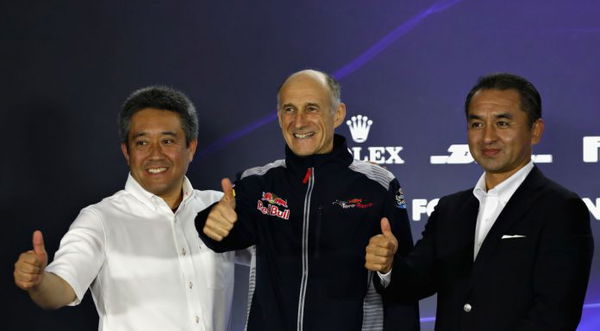

When Honda chose to return for a fourth time in 2015 with McLaren, their target was minimum one victory – but it aimed to achieve so much more, particularly given its success with the British team the last time they joined forces in the late 1980s and early ’90s. But Honda’s ambition were in for harsh reality.
Honda struggled with performance and unreliability in the first year. They improved marginally last term. But then in pre-season testing for 2017, it became clear it had gone backwards. McLaren realised it needed to find a way out.
Honda was aware it had failed to meet its targets, but refused to give up. It wanted to save the relationship and fight to achieve the goal the two parties had set back in 2015.
ADVERTISEMENT
Article continues below this ad
Between them, they came up with a three-stage development plan that would require Honda to meet three performance targets.
Honda failed to meet the first two and McLaren lost its cool publicly. Then over the summer McLaren upped its bid to extricate itself from the deal.
Honda had some thinking to do, too. Its board members spent hours debating its future. There was a feeling among some that it may be better to limit the damage and quit F1 altogether. Others steadfastly refused to give up. It could have gone either way.
There was another option on the table – a possibility to supply Toro Rosso with engines next season. It would replace the second Honda deal vacated by Sauber, to aid development and boost its cause with McLaren. It would also act as a back-up in case Honda could not save the McLaren relationship.

via Imago
The deal that could have been
But the board did not want to take too much on and instead was in favor of putting all of its eggs into the McLaren basket. McLaren was the team it had set out on this journey with and Honda wanted to complete it together. So talks with Toro Rosso collapsed.
Honda had one more shot to prove it could deliver with an update at the Belgian Grand Prix. But it could only bring part of the package, and the performance did not meet expectations.
With McLaren now clear it would find a way to exit the partnership, and Honda sticking to its stance that it was focusing fully on saving its McLaren deal, the Japanese manufacturer’s future in F1 was at risk.

via Imago
Mr. Masashi Yamamoto
But general manager of Honda motorsport Masashi Yamamoto, driven by thoughts of Honda’s ‘racing spirit’, refused to give up. Talks with Toro Rosso restarted, and they accelerated in the build-up to the Italian GP. Yamamoto headed back to Japan and presented his vision to the board when it was clear that a deal could be done. He spent days battling to convince them it was the right thing to do.
Yamamoto had backing from the FIA, with president Jean Todt writing a personal letter to the Honda CEO Takahiro Hachigo expressing his support and wish to find a way to keep Honda in F1. Liberty Media chiefs backed Honda, too. Neither party was prepared to let it quit.
The board eventually relented, with Hachigo understood to have been convinced of the new F1 project and then becoming instrumental in bringing the board on side. That was what ultimately made the difference. Yamamoto then went back to Red Bull and the deal was sorted in a matter of days. Honda would stay in F1 – with Toro Rosso.

via Imago
The force to reckon with?
Honda openly admits it has not done the job it had hoped to do when it signed up for a return. Yamamoto was asked if Honda’s failure to meet performance targets set for Spain, Canada and Belgium was the cause of the McLaren break-up. He told the press: “I don’t think those three races were the critical reasons but rather it had already been three years. The reason is we couldn’t show enough improvement after three years. That is what made the difference.”
Privately, it is believed there was concern among Honda’s board members that the brand was being damaged by consistently poor performances, making Yamamoto’s task to convince them to stay harder.
Yamamoto’s argument for staying in F1 had three key strands.
Step 1:
The first was the budget. Honda invested in the region of $100million into McLaren during each year of its partnership. Fernando Alonso’s salary came from most of this money.
That will not happen with Toro Rosso, presenting a huge saving to the board.
But that is the only difference. The Toro Rosso agreement is a full works deal, so the engine and development is free. Honda plans to maintain its workforce, and is even open to strengthening in key areas. It is also pushing ahead with development, while maintaining a capacity to take on a second team in the future.

via Imago
Helmut Marko
Step 2:
The second strand is the long-term potential. When the talks with Toro Rosso first started, Red Bull motorsport advisor Helmut Marko expressed interest in Red Bull using the engines in the future. On the condition that Honda could show enough improvement in its opening season with Toro Rosso.
Losing McLaren hurt Honda’s pride, but here was an opportunity to link up with another big name relatively quickly. Such opportunities do not come up often, but Red Bull’s frustration with current supplier Renault and failure to entice Ferrari and Mercedes to supply it has left it with little other option as things stand.
Honda can now spend a season away from the pressure cooker. It can focus on developing and improving its power unit with Toro Rosso. The potential prize is a deal with Red Bull from 2019 onwards.
Should Honda deliver, it can link up with a team that it knows needs Honda as much – if not more than – Honda needs Red Bull. It then has two years to convince Red Bull that it is worth sticking with beyond 2021, when the engine regulations change.

via Imago
Aston Martin Red Bull Racing
Red Bull is hedging its bets, by strengthening its ties with Aston Martin to now include title sponsorship. Red Bull boss Christian Horner has been vocal in pushing for a simplified engine formula with reduced costs, as he knows that is what is key to Aston as an engine supplier.
If Red Bull does choose to go with Aston Martin, Honda’s future in F1 will hang on whether it has improved enough to convince another team that it is worth teaming up with.
Whether or not Honda can improve remains to be seen, but the smaller, compact nature of Toro Rosso, versus the big, “systematic” McLaren outfit could be the ideal environment for the Japanese manufacturer to do that in.
“Toro Rosso is a smaller team, so they are a good size to have a good communication with Honda, compared to McLaren,” says Yamamoto. He further adds “On the other hand McLaren is sometimes too systematic. Because of the system they have, it takes time to make small tweaks for improvements. Maybe with Toro Rosso, they are small enough to make changes quickly.”
The core parts of the future engine formula are still being fleshed out. But there is a hope among the key stakeholders that they will be finalised before the end of the year. Right now, even before that has become clear, Honda is looking at the long term.
Step 3:

via Imago
Honda’s Japanese driver dream
The third strand in Yamamoto’s argument was Honda’s desire to bring a Japanese driver through to F1. It is one of the reasons why Honda returned to the grid. Sauber offered an opportunity to make that reality, but it disappeared when that deal fell through.
There is no clause in the contract with Toro Rosso that says Honda can place a Japanese driver. But there will be discussions regarding the possibility of doing so, and long-term Toro Rosso, by its nature as Red Bull’s junior team, does provide a vehicle with which Honda can achieve its aim.
ADVERTISEMENT
Article continues below this ad
“Having a Japanese driver is good not only for Honda but for Japanese motorsport itself,” says Yamamoto. “People in Japan will be more interested in motorsport if we have heroes.”
The task facing Honda remains daunting and there is no guarantee it will succeed. But for now, it is throwing hefty resources to start. In the words of Honda’s chief officer of brand and communications operations Katsuhide Moriyama, “it is a new chapter for Honda F1”.
Moriyama adds: “Our spirit, Honda’s spirit, is going to come back and for next year our goal is to fight the top three at the front of the grid.”
ADVERTISEMENT
Article continues below this ad
It’s an ambitious goal, and one it is unlikely to achieve next year. But it stems out of a relentless ambition that has successfully turned Honda into one of the most successful automotive companies in the world, with a pretty impressive motorsport history to boot.
Honda’s racing spirit is still strong and it’s not yet prepared to give up the F1 fight.
ADVERTISEMENT
ADVERTISEMENT
ADVERTISEMENT
ADVERTISEMENT

